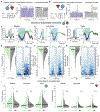Alzheimer's pathology causes impaired inhibitory connections and reactivation of spatial codes during spatial navigation
- PMID: 33882308
- PMCID: PMC8139125
- DOI: 10.1016/j.celrep.2021.109008
Alzheimer's pathology causes impaired inhibitory connections and reactivation of spatial codes during spatial navigation
Abstract
Synapse loss and altered synaptic strength are thought to underlie cognitive impairment in Alzheimer's disease (AD) by disrupting neural activity essential for memory. While synaptic dysfunction in AD has been well characterized in anesthetized animals and in vitro, it remains unknown how synaptic transmission is altered during behavior. By measuring synaptic efficacy as mice navigate in a virtual reality task, we find deficits in interneuron connection strength onto pyramidal cells in hippocampal CA1 in the 5XFAD mouse model of AD. These inhibitory synaptic deficits are most pronounced during sharp-wave ripples, network oscillations important for memory that require inhibition. Indeed, 5XFAD mice exhibit fewer and shorter sharp-wave ripples with impaired place cell reactivation. By showing inhibitory synaptic dysfunction in 5XFAD mice during spatial navigation behavior and suggesting a synaptic mechanism underlying deficits in network activity essential for memory, this work bridges the gap between synaptic and neural activity deficits in AD.
Keywords: 5XFAD; Alzheimer’s disease; inhibition; interneurons; monosynaptic connections; neural coding; place cells; reactivation; sharp-wave ripples.
Copyright © 2021 The Authors. Published by Elsevier Inc. All rights reserved.
Conflict of interest statement
Declaration of interests The authors declare no competing interests.
Figures





Similar articles
-
Early alterations in hippocampal perisomatic GABAergic synapses and network oscillations in a mouse model of Alzheimer's disease amyloidosis.PLoS One. 2019 Jan 15;14(1):e0209228. doi: 10.1371/journal.pone.0209228. eCollection 2019. PLoS One. 2019. PMID: 30645585 Free PMC article.
-
Inhibitory Parvalbumin Basket Cell Activity is Selectively Reduced during Hippocampal Sharp Wave Ripples in a Mouse Model of Familial Alzheimer's Disease.J Neurosci. 2020 Jun 24;40(26):5116-5136. doi: 10.1523/JNEUROSCI.0425-20.2020. Epub 2020 May 21. J Neurosci. 2020. PMID: 32439703 Free PMC article.
-
Inhibitory Neural Network's Impairments at Hippocampal CA1 LTP in an Aged Transgenic Mouse Model of Alzheimer's Disease.Int J Mol Sci. 2021 Jan 12;22(2):698. doi: 10.3390/ijms22020698. Int J Mol Sci. 2021. PMID: 33445678 Free PMC article.
-
Hippocampal Interneurons Shape Spatial Coding Alterations in Neurological Disorders.Mol Neurobiol. 2025 May 20. doi: 10.1007/s12035-025-05020-2. Online ahead of print. Mol Neurobiol. 2025. PMID: 40392508 Review.
-
Synaptic therapy in Alzheimer's disease: a CREB-centric approach.Neurotherapeutics. 2015 Jan;12(1):29-41. doi: 10.1007/s13311-014-0327-5. Neurotherapeutics. 2015. PMID: 25575647 Free PMC article. Review.
Cited by
-
Precocious emergence of cognitive and synaptic dysfunction in 3xTg-AD mice exposed prenatally to ethanol.Alcohol. 2023 Mar;107:56-72. doi: 10.1016/j.alcohol.2022.08.003. Epub 2022 Aug 28. Alcohol. 2023. PMID: 36038084 Free PMC article.
-
Resilient Hippocampal Gamma Rhythmogenesis and Parvalbumin-Expressing Interneuron Function Before and After Plaque Burden in 5xFAD Alzheimer's Disease Model.Front Synaptic Neurosci. 2022 May 11;14:857608. doi: 10.3389/fnsyn.2022.857608. eCollection 2022. Front Synaptic Neurosci. 2022. PMID: 35645763 Free PMC article.
-
Neuromodulation of Chemical Synaptic Transmission Driven by THz Photons.Research (Wash D C). 2022 Dec 19;2022:0010. doi: 10.34133/research.0010. eCollection 2022. Research (Wash D C). 2022. PMID: 39285946 Free PMC article.
-
Progressive Excitability Changes in the Medial Entorhinal Cortex in the 3xTg Mouse Model of Alzheimer's Disease Pathology.J Neurosci. 2023 Nov 1;43(44):7441-7454. doi: 10.1523/JNEUROSCI.1204-23.2023. Epub 2023 Sep 15. J Neurosci. 2023. PMID: 37714705 Free PMC article.
-
Transcranial magneto-acoustic stimulation improves spatial memory and modulates hippocampal neural oscillations in a mouse model of Alzheimer's disease.Front Neurosci. 2024 Feb 7;18:1313639. doi: 10.3389/fnins.2024.1313639. eCollection 2024. Front Neurosci. 2024. PMID: 38384480 Free PMC article.
References
-
- Abramov E, Dolev I, Fogel H, Ciccotosto GD, Ruff E, and Slutsky I (2009). Amyloid-β as a positive endogenous regulator of release probability at hippocampal synapses. Nat. Neurosci. 12, 1567–1576. - PubMed
-
- Alonso JM, Usrey WM, and Reid RC (1996). Precisely correlated firing in cells of the lateral geniculate nucleus. Nature 383, 815–819. - PubMed
Publication types
MeSH terms
Grants and funding
LinkOut - more resources
Full Text Sources
Other Literature Sources
Medical
Molecular Biology Databases
Miscellaneous

